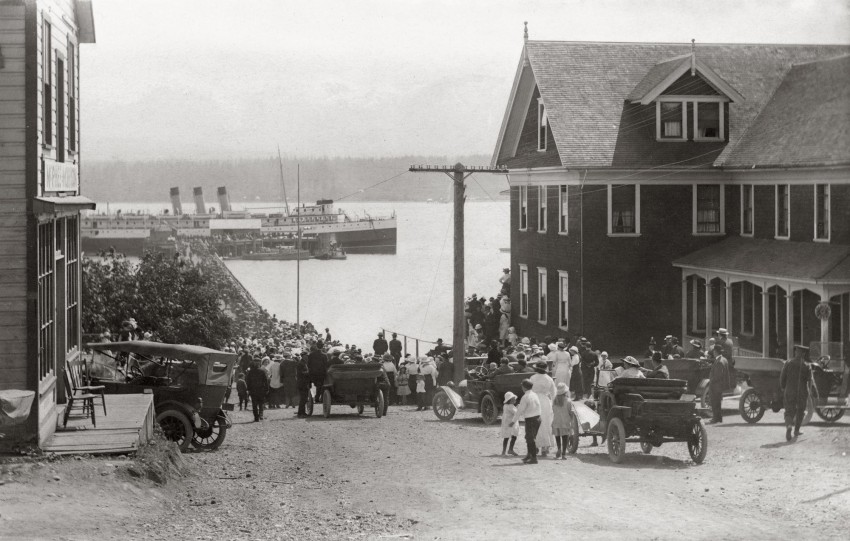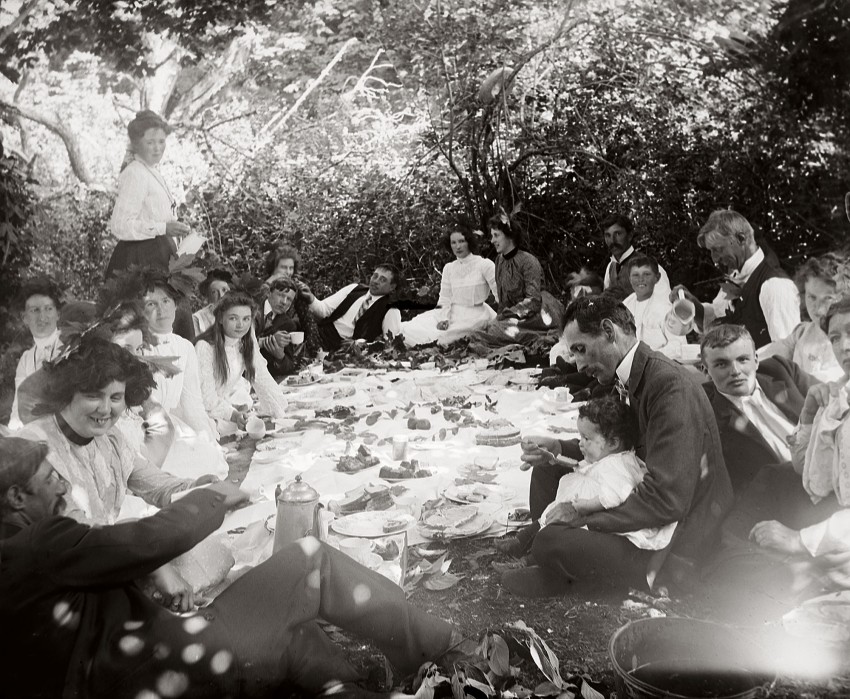#33 Courtenay gets its due
October 30th, 2016
REVIEW: Watershed Moments: A Pictorial History of Courtenay and District
By Christine Dickinson, Deborah Griffiths, Judy Hagen, and Catherine Siba
Madeira Park: Harbour: 2015. $34.95. ISBN 13: 978-1-55017-722-0
Reviewed by Howard Stewart.
*
Comox Valley writers and Courtenay Museum curators Christine Dickinson, Deborah Griffiths, Judy Hagen, and Catherine Siba have assembled a “pictorial history” that offers a highly memorable collection of images from the Comox Valley ranging from the late nineteenth to the mid twentieth century.
Watershed Moments provides a valuable outlet for the Courtenay and District Museum’s remarkable photo collection, which fully deserves to be known beyond the Comox Valley. Alive to the importance of local physical geography, the authors have included many pictures that remind us of the primary importance of the sea and the rivers, and of the mountains and the trees, in forming successive human societies in this rich place.
As a coherent historical narrative, the book sometimes has a tendency to skim across subject matter that is too vast, too complex, and too diverse to be captured in this kind of book. That’s going to happen with this sort of pictorial overview, no matter how you slice it.
While the earliest photos bounce around the valley, the collection becomes more focused on the town of Courtenay when it became the local urban centre with the arrival of the Esquimalt & Nanaimo Railway there in 1914. Also included are some haunting images of the valley’s Indigenous people, as well as a few of Japanese Canadians, and a sample taken by my grandmother Ellen Stewart (nee Nellie Holmes) of Cumberland’s Chinese Canadians. Not surprisingly, considering who took most of the pictures, the collection is especially strong when it comes to showing the valley’s white settler society, at rest, at work, and at play.
In their concluding remarks, the authors acknowledge that they have offered only glimpses of the region’s story since the beginning of Eurasian resettlement. Photographs are the book’s great strength, but the authors are perhaps too modest when assessing the quality of what they have chosen to share with us. In fact, they had a large museum collection to choose from — and they have chosen very well.

Crowds at Comox Wharf watching the boys of the 102nd Battalion leave for Europe, via Vancouver. Courtenay & District Museum & Archives.
There are too many stunning photos to mention. Some of my favourites include the Gage family portrait with pet deer (vi), the young Carroll girls (viii), the turn of the century groups of Indigenous people at the K’omoks Village (18-19, 76), the anonymous boaters in front of the Union Bay coal dock (50-51), the Chinese funeral at Cumberland (54-55), the crowds milling to watch their boys head off on a journey to Europe from which so many would not return (130-132), the Little River picnic (120-121), the many images of Courtenay’s iconic early buildings such as the stunning log house that is the Native Sons Hall (140-143) — one of the very few that survives to this day.

Turn of the century Indigenous group at the K’omoks Village. Courtenay & District Museum & Archives.
The format of the book allows the authors to highlight these captivating images, but it also condemns them to the impossible task of capturing the essence of what was actually going on in a disjointed collection of anecdotes arranged in sidebars beside the photos. Every picture introduces a story — at least one story — but the accompanying texts, when taken together, form an unfocused kaleidoscope of often disconnected stories.
Without a great deal more text and analysis, it would have been impossible to tell a coherent story based on this complex collage of images drawn from a century of overlapping and sometimes awkward histories of the Comox Valley’s diverse social and ethnic groups, and to tease out the shifting and complicated relations among them.
The authors claim to be inspired by a spirit of optimism, tolerance, humour, strength of character, and generosity. While undoubtedly making for harmonious communities, these qualities are not necessarily assets when it comes to historical investigation, and the reader is arguably left with one-dimensional depictions of evolving relations among indigenous peoples, Asian immigrants and settlers of European descent.
Issues, for example, like the dispossession and demographic collapse of Indigenous people and the expulsion of Japanese-Canadians are mentioned in passing, but they are curiously detached from any broader narrative. The devastating scars left by the 1914-18 war are breezily dismissed with the Panglossian assurance that “These losses created a new enjoyment of life and a resolve that carried into the next decades…” (133).
And finally, despite the admirable emphasis on the physical geography of the place, the authors provide little discussion of the vast transformations to the Comox Valley’s landscapes, rivers, shorelines, and forest and mineral resources that have accompanied the region’s resettlement since the 1860s.
But one must invoke an old chestnut: they were damned if they did and damned if they didn’t. The authors had to write something to go with every picture. Most of the bits they wrote were cogent and thoughtful. It’s a moot point as to whether they evoke a rich visual collage rather than a striking and coherent depiction of a landscape and its people, such as provided of the Comox Valley by the artist E.J. Hughes or the novelist Jack Hodgins.
To invoke a second chestnut: ideally, in creative work, the whole is greater than the sum of its parts. It’s up to each reader and viewer to decide for themselves whether the parts, pieces, and images presented in Watershed Moments successfully jell into a cohesive portrait of the fascinating rural and urban communities of the Comox Valley.
*
 Howard Macdonald Stewart is an historical geographer and international consultant who writes from Denman Island where he has lived, off and on, for more than thirty years. He has worked in more than seventy countries since the 1970s. Now intensely allergic to airplanes, he has contributed many book reviews to BC Studies and is now providing reviews about the B.C. coast for The Ormsby Review. His forthcoming book on five parallel histories of the Strait of Georgia / North Salish Sea is scheduled for publication by Harbour Publishing in 2017. It will be based on his doctoral research in the Geography Department at UBC. An insider’s view of his four decades on the road, notionally titled Around the World on Someone Else’s Dime: Confessions of an International Worker, is also a work in progress.
Howard Macdonald Stewart is an historical geographer and international consultant who writes from Denman Island where he has lived, off and on, for more than thirty years. He has worked in more than seventy countries since the 1970s. Now intensely allergic to airplanes, he has contributed many book reviews to BC Studies and is now providing reviews about the B.C. coast for The Ormsby Review. His forthcoming book on five parallel histories of the Strait of Georgia / North Salish Sea is scheduled for publication by Harbour Publishing in 2017. It will be based on his doctoral research in the Geography Department at UBC. An insider’s view of his four decades on the road, notionally titled Around the World on Someone Else’s Dime: Confessions of an International Worker, is also a work in progress.
The Ormsby Review. More Reviews. More Often. More Readers.
Reviews Editor: Richard Mackie
Reviews Publisher: Alan Twigg





Leave a Reply